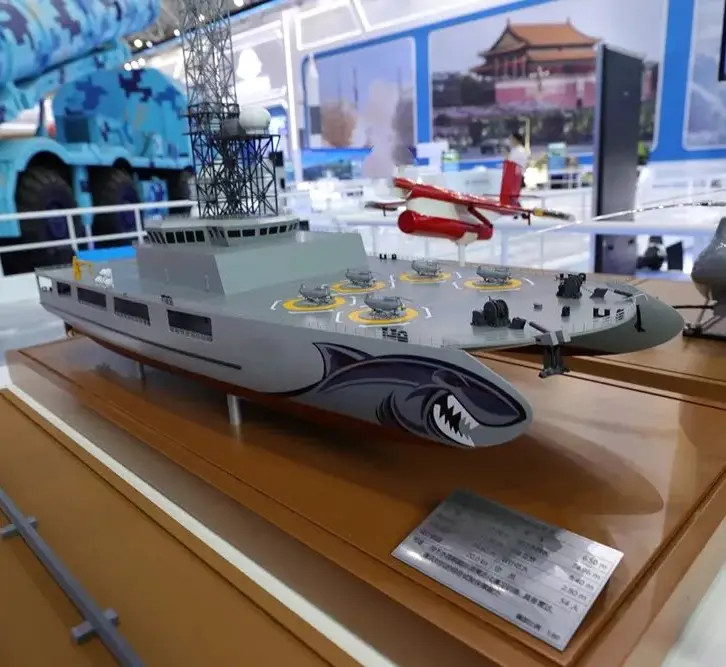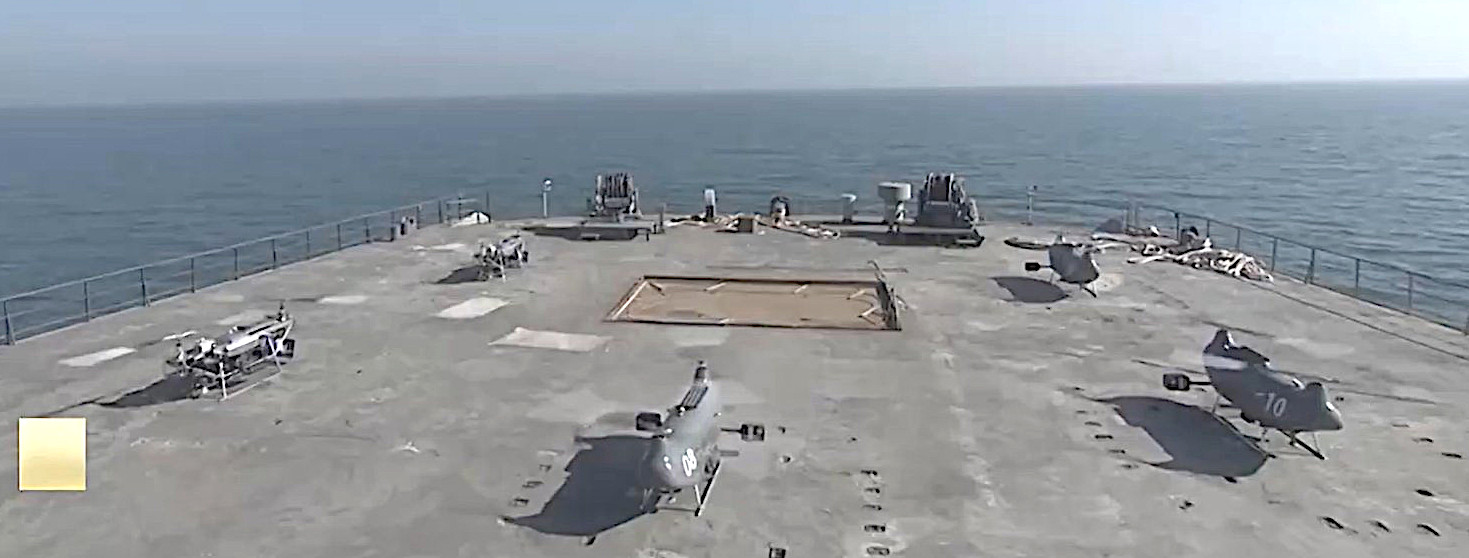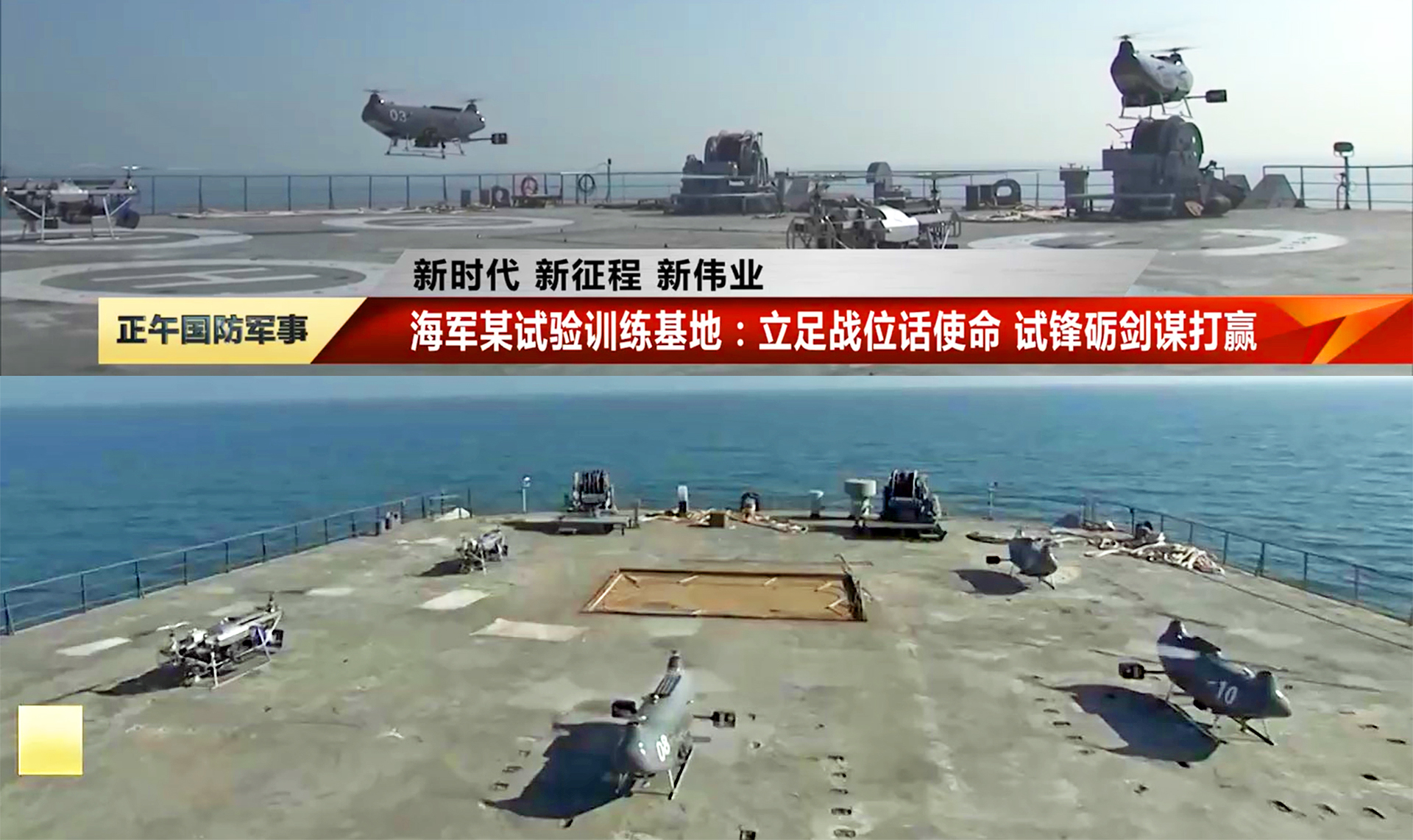China’s People’s Liberation Army Navy, or PLAN, appears to have put an unusual catamaran drone mini-carrier into service as part of an experimental naval training force. The War Zone was the first to report in detail on this ship, which was launched in May 2021 and looks to be intended ostensibly to simulate enemy drone swarms, as well as other threats, such as high-volume anti-ship missile strikes and distributed electronic warfare attacks, during training exercises.
Footage of what appears to be the training ship was included in a short segment broadcast on Chinese state television station CCTV-7 today about what is described as a “Navy Experimental Training Base,” according to a machine translation. CCTV-7 is focused on news about the People’s Liberation Army (PLA). Overall, the segment shows various land-based and maritime training and/or test and evaluation activities involving shore-based systems, surface warships, and submarines, with a clear emphasis on naval countermeasures and other shipboard self-defense systems.
The b-roll running in the background during the CCTV-7 segment includes two brief and distinct clips showing what appears to be the forward flight deck of the catamaran drone carrier. Though a full view of the ship is never given, a number of very unique features are visible that are similar if not identical to those seen on a model of the vessel that the state-run China Aerospace Science and Industry Corporation, or CASIC, had on display at the 2021 Zhuhai Airshow. These include two large anchor line reels at the bow and five landing pads for drone helicopters.


Interestingly, one of the two clips that CCTV-7 included in its segment today shows the helipads marked with circles with the Latin letter “H” in the center, while the pads in the other look to be unmarked. This would seem to indicate that the two videos were taken at significantly different times. This may also raise a question about whether the PLAN has more than one of these ships, though this seems less likely. There have been no indications one way or another that a second one was launched after the first was last year.


In addition, a number of the uncrewed helicopters seen in both clips shown today on CCTV-7 are of a distinctive tandem-rotor design, a relatively uncommon configuration for uncrewed rotorcraft, which was showcased along with CASIC’s model of the catamaran training vessel at Zhuhai last year. These are readily identifiable by a bar underneath one end of the fuselage with what has looked to be a radiofrequency signal emitter of some kind installed on either end. Their portly fuselages would provide space for additional mission systems.

These drone helicopters may be a variant or derivative of the ZC Aviation ZC300, which the PLA has at least evaluated in the past as a way to transport small cargoes. ZC Aviation’s website, which does not appear to have been updated in any significant way since 2020, shows additional versions configured for agriculture and fire-fighting work, but none for obvious military use. This drone was reportedly developed in cooperation with Hainan Tropical Ocean University, and there was talk in the past about the possibility of equipping examples with laser-imaging sensors and small radars ostensibly for “oceanic observation research.”
The clips also show another tandem-rotor drone helicopter design that looks to be similar in size to the possible ZC300-based type, but that has a much more stripped-down, open-framed design.

If the CCTV-7 segment today does indeed show the catamaran drone carrier, it is not clear how it might otherwise be configured without a full view of it. The model at Zhuhai last year showed that the vessel had a large open rear deck, which could be used for launching and recovering other kinds of drones, among other things, and a large tower on top of its central superstructure with a number of antenna domes. The domes could be part of the control systems for the drones, as well as other communications and data-sharing links. The very top of the tower, in particular, would be a very good position for line-of-sight links. You can read more about the ship and its possible capabilities in The War Zone‘s past analysis here.
All told, the ship would look to be able to provide a valuable platform for helping to simulate drone swarms, high-volume anti-ship cruise missile strikes, and large-scale electronic warfare attacks, among other threats, across a broad area, and doing so at a relatively low cost. These capabilities would be very useful for training purposes, as well as for supporting research and development and test and evaluation activities, such as work on new and improved naval countermeasures. This is all well in line with the CCTV-7 segment today, which appeared more focused on the PLAN’s development and testing of naval countermeasures and self-defense systems.
This is also just more evidence that the PLA, in general, and the PLAN, specifically, have been working to expand their training and test forces to be better able to replicate various types of advanced enemy capabilities, including networked drone swarms and electronic warfare systems, which are very real threats now. A rail-based system and a modular barge that CASIC also displayed in model form alongside the catamaran drone carrier at Zhuhai last year, and that look to have similar training and test roles, have also turned out to be real capabilities now in PLA use.
All of this is hardly surprising given that is an arms race of sorts going on between the Chinese and the United States at present across various arenas, including the development of uncrewed systems, autonomous technology, and electronic warfare capabilities, among many others. The PLA, as a whole, is well aware of these threats given the strides that it has made in recent years in developing and fielding various systems that fall into these categories.
As a prime example of all of this, U.S. military-sponsored wargaming, as well as simulations run by various organizations independently, has increasingly shown that networked swarms of drones with electronic warfare packages, among many other capabilities, and with high degrees of autonomy, could be game-changing in any future high-end conflict between American and Chinese forces over Taiwan. With this in mind, there is the possibility that the PLAN could employ the catamaran drone carrier, as well as the modular training barge, or additional similar maritime platforms, as actual operational assets, in a future conflict.
In addition, U.S. military officials have become increasingly outspoken about the threats that drones, including lower-end commercial types, pose to its forces abroad and at home, even outside of traditional conflicts. This very much applies in the context of maritime operations where the U.S. Navy has experienced a growing number of drone-related incidents, including instances of harassment of its warships by multiple uncrewed systems right off the coast of the United States.
If nothing else, it will be interesting to see what else might now emerge about this catamaran drone carrier and its work supporting the PLAN’s training and test forces.
Contact the author: joe@thedrive.com
